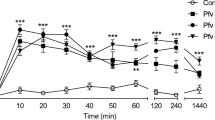Abstract
Melittin (MLT) (10 μg/paw) and D49 (0.4 μg/paw) were injected into the hind paw of male CD-1 mice and elicited 70–80% of maximal paw edema responses at 60 and 30 min after injection, respectively. D49 paw edema was significantly inhibited by anti-histamine/serotonin agents, a PAF antagonist, a PLA2 inhibitor, and some but not all 5-LO and CO inhibitors, indicating that this edema is produced by several classes of inflammatory mediators with mast cell degranulation apparently playing a major role. In contrast, MLT paw edema was not inhibited effectively using the same pharmacological agents except theophylline, suggesting it was elicited via a different sequence of inflammatory events. In summary, D49 and MLT paw edema models were found to be ineffective models to identify experimental PLA2 compounds in our laboratory.
Similar content being viewed by others
References
W. Calhoun, J. Yu, A. Sung, T. T. Chau, L. A. Marshall, B. M. Weichman and R. P. Carlson,Pharmacologic modulation of D-49 phospholipase A 2-induced paw edema in the mouse. Agents Actions,27, 418–421 (1989).
Giuseppe Cirino, Susan H. Peers, John L. Wallace and Roderick S. Flower,A study of phospholipase A 2-induced oedema in rat paw. European J. Pharmacol.166, 505–510 (1989).
Soo Hyung Choi, Tatsuo Sakamoto, Osamu Fukutomi, Naoki Inagaki, Naosuke Matsuura, Hiroichi Nagai and Akihide Koda,Pharmacological study of phospholipase A 2-induced histamine release from rat peritoneal mast cells. J. Pharmacobio-Dyn.,12, 517–522 (1989).
G. Cirino, C. Cicala and L. Sorrentino,Effect of BK-antagonists and LNMMA on PLA 2-induced oedema in rat paw. Abstract book, International Congresses on Inflammation, p. 183 (June 1990).
J. J. Moreno, G. Carganico and E. Bastida,Mediators involved in the early inflammatory reaction induced by intradermal injection of phospholipase A 2 (PLA 2). Abstract book, International Congresses on Inflammation, p. 262 (June 1990).
John S. Bomalaski, Daniel G. Baker, Lynne Brophy, Norman V. Resurreccion, Isaias Spilberg, Miguel Munian and Mike A. Clark,A phospholipase A 2-activating protein (PLAP) stimulates human neutrophil aggregation and release of lysosomal enzymes, superoxide, and eicosanoids. J Immunol,142, 3957–3962 (1989)
Hassan Salari, Pierre Braquet and Pierre Borgeat,Stimulation of lipoxygenase product synthesis in human leukocytes and platelets by melittin. Molecular Pharmacol,28, 546–548 (1985).
Marinne S. de Carvalho and R. S. Jacobs,Inhibition of eicosanoid release by scalaradial, a phospholipase A 2 inhibitor. Pharmacologist,32, 273 (1990).
Author information
Authors and Affiliations
Rights and permissions
About this article
Cite this article
Hartman, D.A., Tomchek, L.A., Lugay, J.R. et al. Comparison of antiinflammatory and antiallergic drugs in the melittin- and D49 PLA2-induced mouse paw edema models. Agents and Actions 34, 84–88 (1991). https://doi.org/10.1007/BF01993245
Issue Date:
DOI: https://doi.org/10.1007/BF01993245




